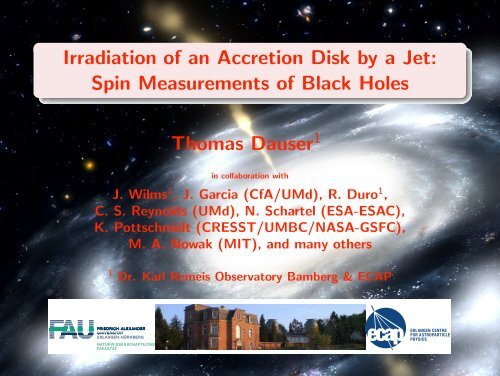Spin Measurements of Black Holes Thomas Dauser
Spin Measurements of Black Holes Thomas Dauser
Spin Measurements of Black Holes Thomas Dauser
You also want an ePaper? Increase the reach of your titles
YUMPU automatically turns print PDFs into web optimized ePapers that Google loves.
Irradiation <strong>of</strong> an Accretion Disk by a Jet:<br />
<strong>Spin</strong> <strong>Measurements</strong> <strong>of</strong> <strong>Black</strong> <strong>Holes</strong><br />
<strong>Thomas</strong> <strong>Dauser</strong> 1<br />
in collaboration with<br />
J. Wilms 1 , J. Garcia (CfA/UMd), R. Duro 1 ,<br />
C. S. Reynolds (UMd), N. Schartel (ESA-ESAC),<br />
K. Pottschmidt (CRESST/UMBC/NASA-GSFC),<br />
M. A. Nowak (MIT), and many others<br />
1 Dr. Karl Remeis Observatory Bamberg & ECAP
What can we learn from the <strong>Spin</strong> <strong>of</strong> a <strong>Black</strong> Hole<br />
Example: Galaxy Evolution<br />
Steady Growth Galaxy Mergers<br />
P(a)<br />
1<br />
0.8<br />
0.6<br />
0.4<br />
0.2<br />
0<br />
-1<br />
Bardeen (1970) Volonteri et al. (2005) King et al. (2008)<br />
0<br />
spin a<br />
1<br />
P(a)<br />
1<br />
0.8<br />
0.6<br />
0.4<br />
0.2<br />
0<br />
-1<br />
0<br />
spin a<br />
1<br />
1<br />
0.8<br />
0.6<br />
0.4<br />
0.2<br />
0<br />
-1<br />
0<br />
spin a<br />
<strong>Spin</strong>: −1 < a < 1 (Rotation Velocity with respect to the Accretion Disk)<br />
⇒ <strong>Spin</strong> could distinguish Galaxy Evolution Models<br />
P(a)<br />
1
What can we learn from the <strong>Spin</strong> <strong>of</strong> a <strong>Black</strong> Hole<br />
Example: Jet Formation<br />
Jet-Formation is connected in most models to the BH spin (e.g.,<br />
Blandford & Znajek, 1977)<br />
Jet Power<br />
<strong>Spin</strong><br />
Gar<strong>of</strong>alo et al. (2010):<br />
most powerful jets from<br />
retrograde (a = −1)<br />
BHs<br />
→ Measuring Jet-Power<br />
vs. <strong>Spin</strong> relation<br />
constrains Jet Models
Irradiation and Reflection<br />
Jet<br />
Accretion Disk
Irradiation and Reflection<br />
Jet<br />
(Reynolds, 1996)<br />
Accretion Disk
Irradiation and Reflection<br />
Jet<br />
Counts per unit energy (arb.)<br />
10 7<br />
10 6<br />
10 5<br />
10000<br />
1000<br />
100<br />
10<br />
1<br />
0.1<br />
0.1<br />
1<br />
Energy [keV]<br />
(Reynolds, 1996)<br />
Ionized Reflection (García & Kallman, 2010; García et al., 2011)<br />
10<br />
Accretion Disk<br />
100
Relativistic effects close to the black hole<br />
β[rg]<br />
40<br />
20<br />
0<br />
-20<br />
-40<br />
-60<br />
-40<br />
-20<br />
α[rg]<br />
0<br />
-0.3 -0.2 -0.1 0.0 0.1 0.2 0.5 1.0<br />
Redshift z<br />
20<br />
40<br />
1.4 1.3 1.2 1.1<br />
E/Ee<br />
1 0.9 0.8 0.6 0.4 -10<br />
0<br />
10<br />
(<strong>Dauser</strong> et al., 2010)<br />
Rotating <strong>Black</strong> Hole: Metric depends on M (mass) and a (spin)<br />
→ special relativistic beaming, light bending, and gravitational redshift<br />
(Kerr, 1963; Cunningham, 1975; Fabian et al., 1989; Laor, 1991; Dovčiak et al., 2004; <strong>Dauser</strong> et al., 2010)<br />
60<br />
10<br />
0<br />
-10<br />
0<br />
10<br />
10<br />
0
Broad Emission Lines<br />
=<br />
Flux [a.u.]<br />
3<br />
2.5<br />
2<br />
1.5<br />
1<br />
0.5<br />
0<br />
+<br />
β[rg]<br />
4.5<br />
40<br />
20<br />
0<br />
-20<br />
-40<br />
-60<br />
-40<br />
-20<br />
α[rg]<br />
0<br />
-0.3 -0.2 -0.1 0.0 0.1 0.2 0.5 1.0<br />
Redshift z<br />
20<br />
40<br />
1.4 1.3 1.2 1.1<br />
E/Ee<br />
1 0.9 0.8 0.6 0.4 -10 0<br />
10<br />
5<br />
Fe Kα (6.4keV)<br />
5.5 6<br />
Energy [keV]<br />
6.5<br />
60<br />
10<br />
0<br />
7<br />
-10<br />
0<br />
10<br />
10<br />
0
Diagnostic potential: inclination<br />
θ = 40 ◦<br />
05◦ θo<br />
10 ◦<br />
20 ◦<br />
30 ◦<br />
40 ◦<br />
50 ◦<br />
60 ◦<br />
70 ◦<br />
80 ◦<br />
5<br />
0.8<br />
ǫ=0.5<br />
a=1.0<br />
E/Ee<br />
0.9<br />
1.0<br />
5.5 6<br />
Energy [keV]<br />
6.5<br />
θ = 80 ◦<br />
1.1<br />
7<br />
10<br />
8<br />
6<br />
4<br />
2<br />
0<br />
Flux [a.u.]
Diagnostic potential: Irradiating Source<br />
h<br />
h=3rg<br />
h=10rg<br />
h=25rg<br />
h=50rg<br />
h=100rg<br />
h=500rg<br />
5<br />
θ=40 ◦<br />
a=+0.99<br />
6<br />
Energy [keV]<br />
determines the incident radiation on the accretion disk<br />
→ low height implies enhanced irradiation <strong>of</strong> the inner parts<br />
radially extended sources are also possible → Jets<br />
7<br />
12<br />
10<br />
8<br />
6<br />
4<br />
2<br />
0<br />
Flux [a.u.]
Diagnostic potential: black hole spin<br />
a<br />
+1.0<br />
+0.8<br />
+0.6<br />
+0.3<br />
+0.0<br />
−0.3<br />
−0.5<br />
−1.0<br />
5<br />
0.8<br />
θo=40 ◦<br />
ǫ=3.0<br />
E/Ee<br />
0.9<br />
1.0<br />
5.5 6<br />
Energy [keV]<br />
6.5<br />
possible <strong>Spin</strong> values: a = −1...1<br />
high <strong>Spin</strong> −→ broad line<br />
1.1<br />
7<br />
4<br />
2<br />
0<br />
Flux [a.u.]
Observations <strong>of</strong> Broad Iron Lines<br />
AGN MCG−6-30-15: a > 0.98<br />
(Brenneman & Reynolds, 2006; Miniutti et al., 2007)<br />
both instruments measure the same line shape<br />
Ratio<br />
1.1<br />
1.05<br />
1<br />
4<br />
5<br />
6 7<br />
Energy [keV]<br />
stellar mass BH Cyg X-1:<br />
a > 0.9 (Duro & <strong>Dauser</strong> et al., 2011)<br />
most prominent Kα line in a stellar<br />
mass BH<br />
8
... yes, broad lines are everywhere<br />
Data/Model<br />
0.9 1.0 1.1 1.2 0.9 1.0 1.1 1.2<br />
stellar mass <strong>Black</strong> <strong>Holes</strong><br />
XTE J1550−564 GRO J1655−40<br />
1.0 1.2<br />
0.8<br />
2 4 6 8 10 2 4 6 8 10<br />
Cygnus X−1<br />
1.1<br />
1.0<br />
GRS 1915+105<br />
2 4 6 8 10 2 4 6 8 10<br />
Energy [keV]<br />
after Miller (2007)<br />
0.9 0.95 1 1.05 1.1<br />
data/model<br />
AGN<br />
NGC 3783 (Brenneman et al., 2011)<br />
5<br />
Energy (keV)<br />
NGC 3516 (Iwasawa et al., 2004)
Constraining the <strong>Spin</strong> from Observations<br />
How good can we distinguish high spin from low spin?<br />
extended Jet compact Jet<br />
high <strong>Spin</strong> low <strong>Spin</strong><br />
2 4 6<br />
2 4 6<br />
Energy [keV] Energy [keV]<br />
1<br />
0.8<br />
0.6<br />
0.4<br />
0.2<br />
0<br />
1<br />
0.8<br />
0.6<br />
0.4<br />
0.2<br />
0<br />
Flux [a.u.]<br />
Flux [a.u.]<br />
(a)<br />
(b)<br />
a = 0.99<br />
a = 0<br />
a = 0.99<br />
a = 0<br />
4<br />
6<br />
Energy [keV]<br />
1.15<br />
1.1<br />
1.05<br />
1<br />
0.95<br />
1.15<br />
1.1<br />
1.05<br />
1<br />
0.95<br />
Ratio<br />
Ratio
Constraining the <strong>Spin</strong> from Observations<br />
How good can we distinguish high spin from low spin?<br />
extended Jet compact Jet<br />
high <strong>Spin</strong> low <strong>Spin</strong><br />
2 4 6<br />
2 4 6<br />
Energy [keV] Energy [keV]<br />
1<br />
0.8<br />
0.6<br />
0.4<br />
0.2<br />
0<br />
1<br />
0.8<br />
0.6<br />
0.4<br />
0.2<br />
0<br />
(a)<br />
(b)<br />
a = 0.99<br />
a = 0<br />
a = 0.99<br />
a = 0<br />
4<br />
6<br />
Energy [keV]<br />
A detected broad line yields the spin and indicates a compact<br />
emission region compact emission region. (<strong>Dauser</strong> et al., 2013)<br />
Flux [a.u.]<br />
Flux [a.u.]<br />
1.15<br />
1.1<br />
1.05<br />
1<br />
0.95<br />
1.15<br />
1.1<br />
1.05<br />
1<br />
0.95<br />
Ratio<br />
Ratio
Robust <strong>Spin</strong> Estimation<br />
AGN 1H0707−495: iron Kα and Lα line detected<br />
νFν[10 −12 × ergs s −1 cm −2 ]<br />
Ratio<br />
1<br />
0.1<br />
0.01<br />
1.5<br />
1<br />
0.5<br />
0.5 1 2<br />
Energy [keV]<br />
5 10<br />
<strong>Dauser</strong> et al. (2012)<br />
first AGN with<br />
detected iron Kα and<br />
Lα<br />
(see, e.g., Fabian et al., 2009;<br />
Zoghbi et al., 2010)<br />
two reflection<br />
components with<br />
different ionization,<br />
high spin (a > 0.99),<br />
and low jet height<br />
(h < 4rg)
Robust <strong>Spin</strong> Estimation<br />
stellar mass BH Cyg X-1: Broad Band Spectrum<br />
νFν [10 −6 × ergs s −1 cm −2 ]<br />
χ<br />
10 XMM-Newton RXTE-PCA RXTE-HEXTE<br />
5<br />
2<br />
1<br />
5<br />
3<br />
1<br />
-1<br />
-3<br />
-5<br />
5 10 20 50<br />
Energy [keV]<br />
100<br />
Integral<br />
200<br />
500<br />
Duro & <strong>Dauser</strong> et al. (2013, in<br />
prep.)<br />
Broad Band<br />
Coverage<br />
(Simultaneous<br />
observations) ( first<br />
robust stellar mass BH spin<br />
measurement)<br />
Cygnus X-1 is a fast<br />
rotating black hole<br />
(a > 0.9), and<br />
compact emission<br />
region (h < 4rg)<br />
<strong>Spin</strong> in agreement<br />
with the “disk-spin”<br />
method (Gou et al., 2011)
Summary<br />
Relativistic effects distort reflection features produced close to the BH<br />
−→ “Broad Emission Lines”<br />
“Line Shapes” are sensitive to the <strong>Spin</strong> and other parameters<br />
A detected broad line yields the spin and indicates a compact emission<br />
region compact emission region<br />
Additional information (e.g.,Broad band spectra) is necessary for robust<br />
spin estimates.
References<br />
Bardeen J.M., 1970, Nat 226, 64<br />
Blandford R.D., Znajek R.L., 1977, MNRAS 179, 433<br />
Brenneman L.W., Reynolds C.S., 2006, ApJ 652, 1028<br />
Brenneman L.W., Reynolds C.S., Nowak M.A., et al.,<br />
2011, ApJ 736, 103<br />
Cunningham C.T., 1975, ApJ 202, 788<br />
<strong>Dauser</strong> T., Garcia J., Wilms J., et al., 2013, MNRAS<br />
687<br />
<strong>Dauser</strong> T., Svoboda J., Schartel N., et al., 2012,<br />
MNRAS 422, 1914<br />
<strong>Dauser</strong> T., Wilms J., Reynolds C.S., Brenneman L.W.,<br />
2010, MNRAS 409, 1534<br />
Dove J.B., Wilms J., Maisack M., Begelman M.C.,<br />
1997, ApJ 487, 759<br />
Dovčiak M., Karas V., Yaqoob T., 2004, ApJ Suppl.<br />
153, 205<br />
Duro R., <strong>Dauser</strong> T., Wilms J., et al., 2011, A&A 533,<br />
L3<br />
Fabian A.C., Rees M.J., Stella L., White N.E., 1989,<br />
MNRAS 238, 729<br />
Fabian A.C., Zoghbi A., Ross R.R., et al., 2009, Nat<br />
459, 540<br />
Fender R.P., Gallo E., Russell D., 2010, MNRAS 406,<br />
1425<br />
García J., Kallman T.R., 2010, ApJ 718, 695<br />
García J., Kallman T.R., Mushotzky R.F., 2011, ApJ<br />
731, 131<br />
Gar<strong>of</strong>alo D., Evans D.A., Sambruna R.M., 2010,<br />
MNRAS 406, 975<br />
Gou L., McClintock J.E., Reid M.J., et al., 2011, ApJ<br />
742, 85<br />
Haardt F., 1993, ApJ 413, 680<br />
Iwasawa K., Miniutti G., Fabian A.C., 2004, MNRAS<br />
355, 1073<br />
Kerr R.P., 1963, Phys. Rev. Lett. 11, 237<br />
King A.R., Pringle J.E., H<strong>of</strong>mann J.A., 2008, MNRAS<br />
385, 1621<br />
Laor A., 1991, ApJ 376, 90<br />
Mark<strong>of</strong>f S., Nowak M.A., Wilms J., 2005, ApJ 635,<br />
1203<br />
Matt G., Perola G.C., Piro L., Stella L., 1992, A&A<br />
257, 63<br />
Miller J.M., 2007, ARA&A 45, 441<br />
Miniutti G., Fabian A.C., Anabuki N., et al., 2007,<br />
PASJ 59, 315<br />
Reynolds C.S., 1996, Ph.D. Thesis, University <strong>of</strong><br />
Cambridge<br />
Ross R.R., Fabian A.C., 2005, MNRAS 358, 211<br />
Volonteri M., Madau P., Quataert E., Rees M.J., 2005,<br />
ApJ 620, 69<br />
Wilms J., Reynolds C.S., Begelman M.C., et al., 2001,<br />
MNRAS 328, L27<br />
Zoghbi A., Fabian A.C., Uttley P., et al., 2010,<br />
MNRAS 401, 2419









![List of participants 27/2/09 [pdf] - Rencontres de Moriond - IN2P3](https://img.yumpu.com/17975746/1/190x135/list-of-participants-27-2-09-pdf-rencontres-de-moriond-in2p3.jpg?quality=85)







